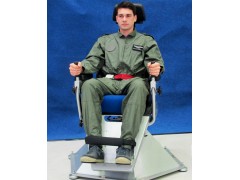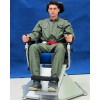The visual and vestibular systems interact to maintain visual clarity of objects during head movement.
The fovea is the part of the eye that has the greatest density of photoreceptors and therefore is the area with the best visual acuity.
During motion, the image of the viewed object tends to slip from the fovea, causing it to blur.
In fact, visual acuity declines to 50 % when an object is 2° from the centre of the fovea.
To maintain an object on the fovea, the eye must make corrective responses.
These corrective eye movements, known as Nystagmus, have a slow phase and a quick phase.
The vestibuloocular reflex (VOR) slow phase keeps the eyes on the foveal vision (opposite direction to head movement).
During rotational chair testing, eyes move in a direction opposite to the rotation of the chair (slow phase eye movements).
The Nystagmus observed is a physiological response and observed with acceleration and deceleration of rotation.
Sustained constant rotation without vision results in a decline of this Nystagmus.
Nystagmus attempts to help stabilise the visual field during movement.
Our semi-circular canals are responsible for informing the brain about our rotational movements and they are mostly unaffected by gravity.
Barany Chair





